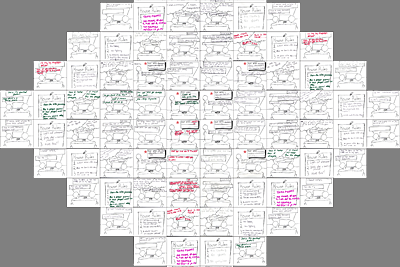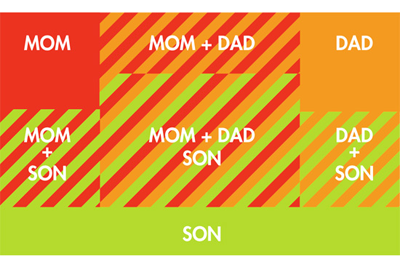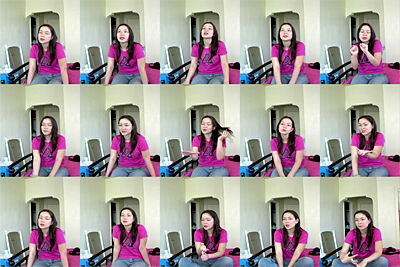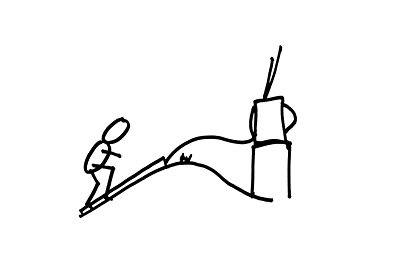Project and
Methods:
Analysis::
Content based:
Asking questions of content, through design
 The comic quilt. A failed attempt at creating new stories from the comics. By focusing on the form and not the content, the experiment revealed nothing new.
The comic quilt. A failed attempt at creating new stories from the comics. By focusing on the form and not the content, the experiment revealed nothing new.
 The sorting structure of the Blux magic bag probe returns. The content of the cards are sorted into a structure. The new for created, from the rules about the content, was then used to understand the boys better.
The sorting structure of the Blux magic bag probe returns. The content of the cards are sorted into a structure. The new for created, from the rules about the content, was then used to understand the boys better.
 Fifteen evenly spaced out video stills from the interview materials form a portrait of the body language for this participant. By using rules to choose the stills and not just those that appealed to me, there can be greater confidence that this is her real body language.
Fifteen evenly spaced out video stills from the interview materials form a portrait of the body language for this participant. By using rules to choose the stills and not just those that appealed to me, there can be greater confidence that this is her real body language.
 The interviews were first transcribed and then individual stories turned in to single image sketches like this one. The synthesis of the story into a new medium forced the designer to understand it better. Also the image becomes an icon for the story, creating any easier way to browse through them.
The interviews were first transcribed and then individual stories turned in to single image sketches like this one. The synthesis of the story into a new medium forced the designer to understand it better. Also the image becomes an icon for the story, creating any easier way to browse through them.
The blank comic's form made it very tempting to re-combine the comics. They are made up of interchangeable squares with similar layouts. Time was spent creating a "quilt" of the squares as well as a random digital sorter for them. Both of these focused on the comic's ease of recombination, but not the content. They allowed for the creation of new stories using the elements of the women's original comics. Neither led to useful outcomes because they were not content driven. The squares lined up and looked like a comic, but the new stories were incomprehensible. A content driven approach would have been to look at the original stories being told and how they could be re-combined and branched together. By not focusing on the content little was achieved.
It is imperative to design rules not outcomes. Designing outcomes is an act of communication. The designer has something he wants to say with the material, and designs an outcome that confirms it. Designing rules is a way of asking questions about the material. Designing rules also encourages the designer to deal with the content. Sorting rules like "all the responses about the past" or "all the images with people in them" require the researcher to look into the material. Content-based rules necessarily make you look at the content in new ways.
While working with the thousands of returns from Blux's magic bag probe it was not possible to design an outcome first, because the material was too vast to be understood. Maria Moon and I were forced to write sorting rules. Those rules brought the material into a more comprehensible form in which clear insights could be drawn. Those insights came from the material and the rules we had written, not from the designers directly. Even when working with more manageable returns it is important to use rules to ask questions of material instead of trying to first create outcomes.
Inspired by work being done in the studio by Miya Osaki and Jin Mi Choi as well as the Dan Perjovshi exhibition at MOMA (Project 85: Dan Perjovschi, May-August 2007), I found success with the technique of moving information through various media. Osaki, Choi, and Perjovshi all were making simple line drawings or doodles of ideas and through simple gestures communicating larger ideas. For WWP the interviews were recorded and parts transcribed. That was the first medium change. In it, much was lost--the visuals, the tone, the pacing of the conversation. However, this loss had benefits. The text could be read much quicker and the loss of information created room for interpretations. The mind will always fill in details when reading a description. Then the written transcripts were turned into simple doodles. The doodles were allowed to be imaginative, exaggerations of what was actually said. Much was lost in the translation into drawings, but again much was gained. The new drawings allowed others to interact with the project without having to read long transcripts. They also became visual icons for stories the women told, icons that could be used and combined in new ways.
At the core of moving information through media is the requirement that content must first be synthesized in the designer's mind before it can be moved into a new medium with different affordances where the original form is often lost. It is this synthesis that generates new understandings.